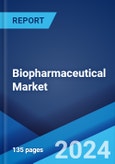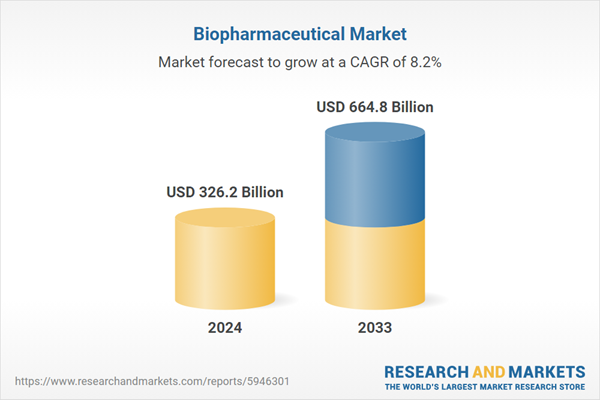Biopharmaceuticals, also known as biologics, are a class of pharmaceutical drugs derived from biological sources. They are produced using living organisms, such as bacteria, yeast, or mammalian cells, through biotechnological processes. Unlike traditional small-molecule drugs, which are chemically synthesized, biopharmaceuticals are large, complex molecules that exhibit highly specific interactions with biological targets in the body. They offer several advantages over traditional pharmaceuticals. They tend to be highly specific in their action, often targeting specific receptors or molecules, resulting in increased efficacy and reduced side effects. Additionally, biopharmaceuticals have the potential to treat diseases that were previously challenging to address using conventional drugs.
The market is experiencing significant growth due to the escalating demand for personalized medicine. In addition, the increasing utilization of biopharmaceuticals to treat cancer, diabetes, psoriasis, and rheumatoid arthritis represents another major growth-inducing factor. Besides, the growing awareness among the masses regarding the effectiveness and availability of biopharmaceuticals represents another major growth-inducing factor. Moreover, the rising focus on rare diseases and orphan drugs is driving the growth of the market. These rare diseases, often characterized by small patient populations, present significant unmet medical needs. Other than this, governments and regulatory agencies worldwide have introduced incentives and streamlined regulatory processes to encourage the development of therapies for these conditions. Moreover, biopharmaceutical companies are investing in R&D to develop orphan drugs, which target rare diseases, thereby addressing critical medical needs and creating opportunities for market expansion.
Biopharmaceutical Market Trends/Drivers
The escalating demand for personalized medicine
Personalized medicine has led to a shift toward targeted therapies and precision medicine approaches in the biopharmaceutical market. Biopharmaceutical companies are increasingly focusing on the development of therapies that target specific genetic mutations, biomarkers, or molecular pathways associated with diseases. Moreover, personalized medicine has led to advancements in pharmacogenomics, which is the study of how an individual's genetic makeup influences their response to drugs. Understanding the genetic variations that impact drug metabolism, efficacy, and safety allows for the identification of patients who may be at risk of adverse reactions or those who are more likely to respond favorably to a specific treatment. This knowledge enables biopharmaceutical companies to develop targeted therapies and dosage regimens tailored to individual patients, enhancing treatment effectiveness and reducing the risk of adverse events.The growing prevalence of chronic and lifestyle-related diseases
Chronic diseases, including cardiovascular disorders, diabetes, cancer, respiratory diseases, and autoimmune conditions, have become major global health challenges. These diseases often have complex underlying mechanisms, requiring targeted and personalized treatment approaches. Biopharmaceuticals, such as monoclonal antibodies, recombinant proteins, and gene therapies, offer precise targeting and tailored treatment options. These therapies can target specific molecular pathways, receptors, or cells associated with chronic diseases, resulting in enhanced efficacy and reduced side effects. Moreover, the increasing burden of chronic and lifestyle-related diseases has shifted the focus from symptomatic relief to disease modification and prevention, which is also propelling the market growth.Various advancements in biotechnology
Biotechnology has greatly accelerated the drug discovery and development process. Advanced techniques, such as high-throughput screening, combinatorial chemistry, and computational modeling, enable the identification and testing of a large number of drug candidates in a shorter time frame. This has led to an increase in the efficiency and speed of drug discovery, allowing biopharmaceutical companies to bring new therapies to market more rapidly. Besides, the ability to analyze an individual's genetic makeup, identify disease markers, and understand molecular pathways has enabled the development of targeted therapies tailored to specific patient populations. Biotechnology tools, such as genomics, next-generation sequencing, and gene editing techniques, have revolutionized the understanding of disease mechanisms and enabled the development of therapies that address specific genetic variations and molecular targets, thus propelling the market.Biopharmaceutical Industry Segmentation
This report provides an analysis of the key trends in each segment of the global biopharmaceutical market report, along with forecasts at the global, regional and country levels from 2025-2033. The report has categorized the market based on indication and class.Breakup by Indication
- Autoimmune Diseases
- Oncology
- Metabolic Disorders
- Others
The report has provided a detailed breakup and analysis of the market based on the indication. This includes autoimmune diseases, oncology, metabolic disorders, and others. According to the report, autoimmune diseases represented the largest segment.
Autoimmune diseases are often chronic and complex conditions that require long-term management and treatment. These diseases can affect multiple organs and systems in the body, leading to a wide range of symptoms and complications. Biopharmaceutical therapies have shown promising results in managing and controlling autoimmune diseases, providing relief from symptoms, slowing disease progression, and improving quality of life for patients. Therapies, including monoclonal antibodies and other biologics, have emerged as a vital treatment option for autoimmune diseases. They target specific molecules, cells, or pathways involved in the autoimmune response, providing more precise and effective therapeutic interventions.
Breakup by Class
- Recombinant Proteins
- Monoclonal Antibodies
- Purified Proteins
A detailed breakup and analysis of the market based on the class has also been provided in the report. This includes recombinant proteins, monoclonal antibodies, and purified proteins. According to the report, monoclonal antibodies accounted for the largest market share.
Monoclonal antibodies are highly specific in targeting disease-specific antigens or cells. They are designed to bind to a specific target with precision, minimizing off-target effects and reducing the risk of adverse reactions. This specificity contributes to their efficacy in treating various diseases, including autoimmune disorders, cancer, inflammatory conditions, and infectious diseases. They also have a wide range of therapeutic applications across different disease areas. They can be used as therapeutic agents on their own or in combination with other treatments. Monoclonal antibodies have been successful in neutralizing pathogens, blocking cell receptors, modulating immune responses, and delivering therapeutic payloads, making them versatile tools for disease management.
Breakup by Region
- North America
- United States
- Canada
- Latin America
- Mexico
- Brazil
- Argentina
- Europe
- Germany
- France
- Italy
- Spain
- United Kingdom
- Russia
- Turkey
- Asia Pacific
- Japan
- China
- Australia
- South Korea
- India
- Indonesia
The report has also provided a comprehensive analysis of all the major regional markets, which include North America (the United States and Canada); Latin America (Mexico, Brazil, and Argentina); Europe (Germany, France, Italy, Spain, the United Kingdom, Russia, and Turkey); and Asia Pacific (Japan, China, Australia, South Korea, India, and Indonesia). According to the report, North America was the largest market for biopharmaceuticals.
North America, particularly the United States, boasts a highly developed healthcare infrastructure, including robust research and development capabilities, advanced clinical facilities, and a strong regulatory framework. The region is home to renowned academic institutions, pharmaceutical companies, and research organizations that drive innovation in the biopharmaceutical industry. The presence of these institutions and infrastructure facilitates the development, manufacturing, and commercialization of biopharmaceutical products. The region has a well-established ecosystem that supports biopharmaceutical innovation, including government funding initiatives, research grants, venture capital investments, and collaborations between academia, industry, and research institutes.
Competitive Landscape
The competitive landscape of the biopharmaceutical market is highly dynamic and competitive, with numerous global and regional players vying for market share. Nowadays, leading biopharmaceutical companies are heavily investing in R&D to discover and develop innovative therapies. They are conducting preclinical and clinical trials, and advance promising candidates through the regulatory approval process. These investments aim to expand their product pipelines, address unmet medical needs, and stay ahead of competitors in terms of therapeutic advancements. They are also forming strategic partnerships and collaborations with academic institutions, research organizations, and other industry players. These alliances enable them to access new technologies, scientific expertise, and complementary resources.The report has provided a comprehensive analysis of the competitive landscape in the market. Detailed profiles of all major companies have also been provided. Some of the key players in the market include:
- AbbVie Inc.
- Amgen Inc
- Biogen Inc.
- Eli Lilly and Company
- F. Hoffmann-La Roche AG
- Johnson & Johnson
- Merck & Co. Inc.
- Novo Nordisk A/S
- Pfizer Inc.
- Sanofi S.A
Recent Developments
Pfizer and BioNTech developed and distributed their mRNA-based COVID-19 vaccine, Comirnaty (BNT162b2). The vaccine received emergency use authorizations and has been widely deployed globally, playing a crucial role in combating the COVID-19 pandemic.Amgen Inc. recently received FDA approval for Lumakras (sotorasib), a targeted therapy for non-small cell lung cancer (NSCLC) with specific genetic mutations.
AbbVie Inc. has made significant advancements in immunology, particularly with its flagship product, Humira (adalimumab). Humira is one of the world's best-selling biologic drugs used to treat autoimmune conditions, including rheumatoid arthritis, psoriasis, and Crohn's disease.
Key Questions Answered in This Report
1. What was the size of the global biopharmaceutical market in 2024?2. What is the expected growth rate of the global biopharmaceutical market during 2025-2033?
3. What are the key factors driving the global biopharmaceutical market?
4. What has been the impact of COVID-19 on the global biopharmaceutical market?
5. What is the breakup of the global biopharmaceutical market based on the indication?
6. What is the breakup of the global biopharmaceutical market based on the class?
7. What are the key regions in the global biopharmaceutical market?
8. Who are the key players/companies in the global biopharmaceutical market?
Table of Contents
Companies Mentioned
- AbbVie Inc.
- Amgen Inc
- Biogen Inc.
- Eli Lilly and Company
- F. Hoffmann-La Roche AG
- Johnson & Johnson
- Merck & Co. Inc.
- Novo Nordisk A/S
- Pfizer Inc.
- Sanofi S.A
Table Information
| Report Attribute | Details |
|---|---|
| No. of Pages | 145 |
| Published | February 2025 |
| Forecast Period | 2024 - 2033 |
| Estimated Market Value ( USD | $ 326.2 Billion |
| Forecasted Market Value ( USD | $ 664.8 Billion |
| Compound Annual Growth Rate | 8.2% |
| Regions Covered | Global |
| No. of Companies Mentioned | 10 |









